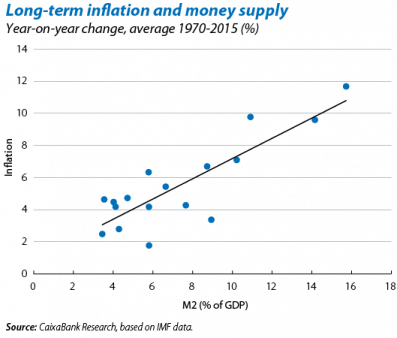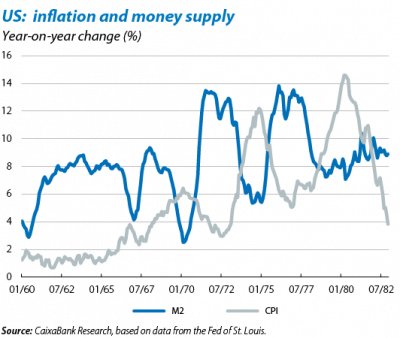A brief history of inflation as a monetary phenomenon
What child has never dreamed of having a machine that prints money? Just imagine: all the toys in the world within our grasp! Nevertheless, what our imagination did not take into account was the fact that money is mainly used as a medium of exchange and, consequently, the more money there is in an economy, the more its goods and services will cost: and there is no point in having double the salary if the cost of living also doubles. The current economic situation, however, contradicts this simple logic, or at least appears to: the monetary stimulus programmes implemented by the US Federal Reserve (Fed) and the European Central Bank (ECB), among others, have resulted in a sharp increase in the creation of money over the last five years but, far from rocketing, inflation has remained persistently below the central banks' targets. We will now examine the reason for this apparent contradiction.
The idea that inflation is higher when the money supply is larger is actually one of most long-standing laws in the discipline of economics. Its origins can be traced back to the writings of the philosophers Martín de Azpilcueta and Tomás de Mercado from the Salamanca School, and also Jean Bodin and David Hume, who were concerned about the impact of precious metals from Spain's American colonies flooding the market.1 And in the 20th century Irving Fisher, one of the great economists of his time, formalised this notion by providing it with an analytical framework which became popular thanks to the famous saying by the holder of the Nobel Prize for Economics, Milton Friedman:
«Inflation is always and everywhere a monetary phenomenon in the sense that it is and can be produced only by a more rapid increase in the quantity of money than in output»2
Today this statement is still fully accepted by economists. However, the relationship between the money supply and inflation lay at the heart of the argument between the two main schools from the 1940s to 1970s: Keynesian economists and monetarists. Both sides accepted Fisher's formalisation which is actually a simple mathematical identity: the value of transactions in an economy must be equivalent to the amount of money circulating in that economy.3 However, while Keynesians were thinking of the short term, during which prices remain relatively rigid, monetarists were focusing on the long term when prices lose their rigidity and adjust to the money supply. Due to this difference in emphasis, Keynesians argued that inflation is mainly affected by real variables (such as the unemployment rate) while monetarists defended the idea that it is primarily a monetary phenomenon (i.e. caused by variations in the money supply). Ultimately this discussion helped to enhance economic theory. At present the distinction between a short-term view with price rigidity and a long-term view with flexible prices is a basic instrument for economic analysis. Although real factors are relevant for short-term fluctuations in inflation we realise that, in the long term, it is determined by growth in the money supply.
The different relationship between the money supply and inflation over different timespans is also well documented and backed by empirical studies. To illustrate its relationship in the long term we have calculated the average annual inflation rate and the average annual growth in the money supply between 1970 and 2015 for a group of 17 advanced economies. As can be seen in the first graph the correlation between both is positive and strong: economies that experienced higher growth in their money supply on average also experienced higher inflation on average.
This exercise may be simple but very similar results can be found in more sophisticated analyses. For example, using advanced statistical techniques, Haug and Dewald (2004) and Assenmacher-Wesche and Gerlach (2007),4 among others, have extracted the cyclical components and long-term trends for inflation and the money supply in a group of industrialised countries. They have found there is a strong correlation between long-term trends in inflation and the money supply while their cyclical components do not seem to be correlated. Assenmacher-Wesche and Gerlach (2007) also show that the cyclical component of inflation correlates with the economy's capacity utilisation. In other words their findings are consistent with the consensus that emerged between Keynesians and monetarists: in the short term real economic activity is a significant determining factor for inflation but in the long term this will ultimately depend on the trend in the money supply.
In fact it is natural that changes in the money supply should take some time to appear in inflation. Returning to our childhood dream of having a machine that prints money, it would be reasonable to assume that the first few notes would make us richer: initially the prices of toys and sweets would remain the same. However, as the weeks passed shopkeepers would end up increasing their prices: inflation is a long-term monetary phenomenon because prices are rigid in the short term. Or at least this was the consensus reached between monetarists and Keynesians. However, eight years have now passed since central banks such as the Fed and ECB began strong monetary expansion to boost their economies after the Great Recession but this expansion has yet to be passed on to inflation, suggesting there must be other relevant mechanisms in play. As discussed in the article «The quest for missing inflation» in this Dossier, over the last few years changes have occurred in how advanced economies work that could explain why prices are taking longer to lose their rigidity. On the one hand the anchoring of inflation expectations means that, in the short term, participants renegotiate prices based on expectations that coincide with the central bank's target. However, in the long term these expectations will only remain rationally anchored if the trend in the money supply is in line with the inflation target. On the other hand globalisation means that part of the money created by a country ends up outside its economic borders, thereby effectively reducing the amount of currency in circulation in the economy in question.
Another obvious difference compared with other episodes is that the recovery in the aggregate demand in advanced economies is slower than expected, making it more difficult for inflation to pick up. For example, in a recession weak credit acts as a brake on demand and thereby reduces inflationary pressures. In fact, a study by the ECB shows that, during recessions, the creation of money by the central bank becomes decoupled from growth in credit.5 Moreover, this decoupling is particularly acute when the recession is accompanied by a financial crisis. The role of credit is fundamental because it acts as a transmission mechanism for the creation of money and its circulation (which is what really affects inflation). As mentioned in a previous Monthly Report,6 there are currently three key factors affecting this transmission: the weak demand for credit (due to heavy borrowing and an uncertain environment), greater caution on the part of suppliers of credit (due to the regulatory changes of Basel III) and relatively low yields in advanced economies (encouraging investors to invest liquidity in other economies with more attractive rates of return). However, as the economic recovery accelerates, these brakes will disappear. In fact, the first two factors can be seen in the banking system's large surplus reserves, especially in the core European countries. If banks decide to turn this surplus into credit, the ECB will have to drain off the excessive liquidity to avoid activating the relationship between the money supply and inflation. In this respect we should not forget the experience of the United States in the 1960s and 70s. As shown by the second graph, although the Fed's accommodative monetary policies in the 1960s and early 70s did not immediately result in higher inflation, this finally reached rates of 14% by the end of the 1970s and the Fed was only able to control it after convincing participants of its commitment to stable growth in the money supply.
In short, the notion that inflation is directly related to the trend in the money supply is one of the oldest and most resilient in the discipline of economics. However, this relationship becomes much stronger over the medium to long term. Although today we do not have higher inflation in response to the large injections of liquidity by central banks, this is due to short-term factors so that the monetary authorities need to remember that, eventually, inflation will be determined by the trend in the money supply.
Adrià Morron Salmeron
Macroeconomics Unit, Strategic Planning and Research Department, CaixaBank
1. Remember that, at the time these authors lived (the 16th to 18th century), silver and gold coins were widely used as currency of exchange.
2. Friedman, M. (1970), «The Counter-Revolution in Monetary Theory», Institute of Economic Affairs Occasional Paper, no. 33.
3. In other words, PY = vM, where Y is the output volume, P is the economy's level of prices, v is the speed at which money circulates and M is the money supply. This expression is correct by definition and can be interpreted as a way of defining v (not observable in the real world).
4. Haug, A. and Dewald, W. (2004), «Longer-term effects of monetary growth on real and nominal variables, major industrial countries, 1880-2001», ECB Working Paper Series, and Assenmacher-Wesche, K. and Gerlach, S. (2007), «Interpreting euro area inflation at high and low frequencies», European Economic Review.
5. ECB, «Money and credit growth after economic and financial crises – a historical global perspective», Monthly Bulletin, February 2012.
6. See the Dossier «Inflation: merely a monetary phenomenon?» in MR02/2015.




